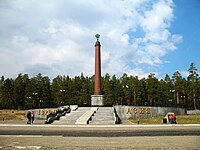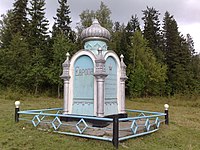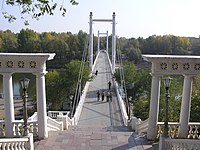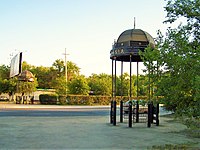|
Philip Johan von Strahlenberg
 Philip Johan von Strahlenberg (1676–1747) was a Swedish officer and geographer of German origin who made important contributions to the cartography of Russia. LifeStrahlenberg was born in Stralsund, which then belonged to Sweden, and his original name was Philip Johan Tabbert. He joined the Swedish army in 1694 and was promoted captain in 1703. In 1707, he was ennobled and took the name von Strahlenberg. Taking part in the Great Northern War, he was captured by the victorious Russian forces during the Battle of Poltava in 1709. As a prisoner of war, he was sent to Tobolsk, where he lived from 1711 to 1721. During this time, he studied the geography of Siberia and the anthropology, languages and customs of its native tribes. After returning to Stockholm in 1730, he published his book Das Nord- und Ostliche Theil von Europa und Asia (North and Eastern Parts of Europe and Asia) with the results of his studies. The book was well received and soon translated into English, French and Spanish. As part of his book, Strahlenberg and Johan Anton von Matérn drew new maps of all of Russia – a formidable task in itself. He also suggested a new border between the continents of Europe and Asia in Russian territory. This border follows the peaks of the Ural Mountains, then branches off westwards along a minor mountain range, follows the hilly west bank of the Volga River downstream to the 49th degree of latitude and the Don River thereon to the Black Sea.[1] Vasily Tatischev claimed that it was at his suggestion that Strahlenberg adopted the idea.[2] Strahlenberg's book also extensively deals with the languages and customs of the Tatars, Yakuts, Chuvash, Crimean Tatars, Uzbeks, Bashkirs, Kyrgyz, Turkmen Tatars and Mongols. He also compiled and published a Kalmyk-German dictionary, subsequently issued with French and English translations. In writing about the shamanic rituals of the indigenous peoples of Siberia, he noted their use of the fly agaric mushroom (Amanita muscaria). In his later years, Strahlenberg wrote an extensive two-volume treatise on the history of Russia, which was published in French translation as Description Historique de l'Empire Russien (Historical Description of the Russian Empire) in 1757. The asteroid (15766) Strahlenberg is named after him. Von Strahlenberg's line Von Strahlenberg, based on his studies, proposed a demarcation line between the European and Asian continents that starts from the Arctic Ocean, including Novaya Zemlya and the Yugorsky Peninsula in Europe, runs along the Ural Mountains, then follows the of the Emba River to the coasts of the Caspian Sea and finally crosses the Kuma–Manych Depression, ending in the Sea of Azov. Today, the Ural River, and not the Emba, is usually used as the border between the two continents.[3] The geographer of Peter the Great, Vasily Tatishchev, had a notable role in the choice of the Eurasian border line, giving it a historical-naturalistic justification. Strahlenberg and Tatishchev had met in 1720 in Tobolsk, and collaborated intensely, so much so that it is thought that the Russian's ideas influenced Strahlenberg's proposals.[4] Russian intellectuals and statesmen were enthusiastic about the line proposed by von Strahlenberg, which was understandable given the ideals of Westernization that were increasingly spreading in Russia in the first half of the 18th century, due to the policies of Peter the Great. The previous conventional line in fact placed the border between Europe and Asia along the course of the Don River, in the heart of Russia, and this was now considered unacceptable. Strahlenberg's line triumphed not only in Russia, but also in the rest of Europe. In 1730, this continental border was officially approved by Anna of Russia and validated by the biologist Peter Simon Pallas and the geographer Carl Ritter, based on their geological research, botanical and faunal.[5] In 1958, the Geographical Society of the Soviet Union (now known as the Russian Geographical Society) adopted the Strahlenberg line as the border between Europe and Asia for school textbooks.[6] Even today, von Strahlenberg's line, with the replacement of the Emba river with Ural river, is followed in the geographical literature of many countries.[7] The convention that places a stretch of the Eurasian border along the Kuma–Manych Depression, although it is widely followed, is not universally accepted: some geographers, especially those from the United States and those who follow their criteria, prefer to follow the Greater Caucasus watershed rather than the course of the two rivers, so as to make the continental border coincides with the political borders of Russia.[8] Monuments marking the Europe-Asia border on von Strahlenberg's lineStarting from the first half of the nineteenth century, about a hundred monuments were installed on the conventional Europe-Asia border based on von Strahlenberg's line, modified with the substitution of the Ural river in place of the Emba river. The first was that of Pervouralsk, built in 1837 on Mount Berezovaja, about which the famous writer Dostoevsky also wrote.[9] The most notable are the following.[10]
Works
See alsoReferences
External linksWikimedia Commons has media related to Philip Johan von Strahlenberg.
|
||||||||||||||||||||||||










